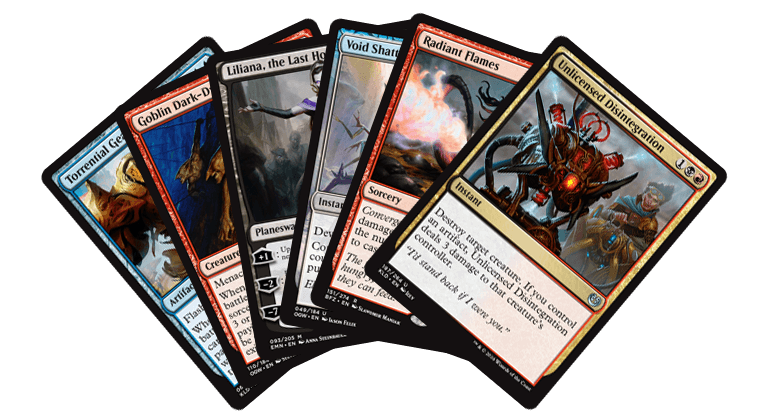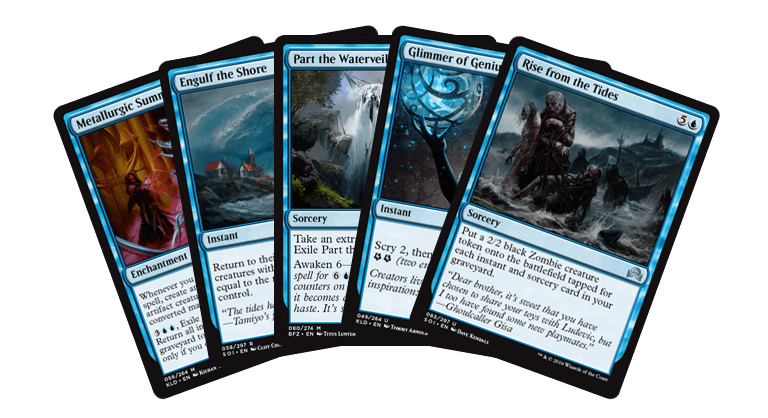How to Build with Blue
Over the next two weeks, we'll be talking about how to build Standard decks that focus on or draw from each of the five colors. Today, because Editor-in-Chief Blake Rasmussen gets to make these kinds of decisions, we'll be starting with blue. If blue isn't your favorite color or you'd rather start building with white, black, red, or green, stay tuned. We'll have the red and green primers tomorrow, and the black and white ones next Tuesday.

Intro to Blue
The color associated with intellect, thought, and construction, blue seems custom-made for Kaladesh and its wondrous inventions. Blue works well with the themes of Kaladesh and is the color that contributes to some of the best decks in Standard. Overall, what can you expect when you use blue magic in your deck?
Countermagic—Blue is the color that can counter other spells. Countermagic's strength is the ability to be a "universal" answer to almost any card as it is cast. Its problem is that it can't deal with cards that have already been cast. If you find yourself behind on the board, countermagic like Void Shatter and Summary Dismissal won't help you catch up with your opponent. When you are using controlling strategies, however, countermagic helps you deal with the diverse strategies of the format very well.
Tempo—Blue is not a great color for permanently getting rid of your opponent's cards once they are in play. What blue prefers is to "bounce" cards back into your opponent's hand or place them on top of the opponent's deck. In the early game, forcing your opponent to cast a creature two turns in a row can provide you with a time advantage. Mount enough of these time advantages and your opponent will find themselves unable to keep up with you.
A blue mage also generates tempo advantage by casting cards that allow them to do multiple things at once. Cards like Reflector Mage, Spell Queller, Cloudblazer, and Torrential Gearhulk each let a blue mage perform two or more strong effects per turn.
Energy—Blue has many efficient energy-creating cards like Aether Meltdown and Glimmer of Genius. It also has many interesting rewards for creating energy, like Confiscation Coup, Era of Innovation, and Aethersquall Ancient. You can also combine blue's energy production with green or red with cards like Bristling Hydra and Whirler Virtuoso for devastating effect.
Top Cards
These are some of blue's top cards in competitive Standard. Understanding these cards and why they are good enough for competitive play will help you utilize blue magic better in your decks.
Torrential Gearhulk is likely the strongest of the Gearhulks. It is a staple in blue-based control strategies because it allows its controllers to play earlier card draw or countermagic while also getting a 5/6 creature at instant speed. The Gearhulk's flash means its owner can leave mana open on the opponent's turn to use it reactively, then turn it into a proactive attacker to finish the game when the coast is clear.
The biggest problem a player using the Gearhulk will have is getting to six mana without falling too far behind in the early turns. If a blue mage can accomplish that, Torrential Gearhulk can turn games around or shut the door on games its controller has in hand.
What does a Blue mage want more than anything? Cards! A blue mage with a full hand of seven cards is a happy mage. Glimmer of Genius doesn't just supply cards though: it offers card selection with it's scry 2 ability, provides two energy, and can be cast at instant speed. The instant speed is relevant because it allows a player to leave mana open to react with countermagic (or a Torrential Gearhulk with countermagic!), drawing cards instead if an opponent fails to cast a relevant spell that turn.
Glimmer of Genius is actually another way that a blue mage can gain tempo, especially against aggressive decks. Being able to reload on cards in hand after your opponent has used all her cards is a definitive advantage in a game of Magic.
Standard has a lot of countermagic. As a rule, it ranges from cheap and narrow effects (Ceremonious Rejection, Negate, Revolutionary Rebuff) to high power with higher costs (Insidious Will, Summary Dismissal, Confirm Suspicions). Void Shatter represents the baseline of countermagic in Standard. For three mana, you can counter any spell. Even better is the fact that you exile that spell, which helps prevent an opponent from reaching delirium with their Ishkanah, Grafwidow or Grim Flayer. While Void Shatter (and countermagic in general) is at its worst versus aggressive decks, it provides flexible control versus slower and more powerful decks.
Cards to Try
These cards don't dominate the Standard scene...yet. Each has unique potential and is worth trying if you like to go off the beaten path.
Metallurgic Summonings requires you to invest a hefty five mana without effect, but once you untap, it's effect can quickly take over games. Gaining a creature for every instant and sorcery you cast doesn't take long to dominate a game. The real trick is building around it effectively. You need a relatively creature-light deck that can keep up with an opponent's spells enough that you won't just die tapping out to cast the Summonings. You can pair Summonings with black or red to get access to enough removal.
Imprisoned in the Moon is not a card that you build an entire deck around, but it is a flexible role player that gives blue the ability to nullify cards that it normally doesn't interact well with—lands and planeswalkers. While it technically gives your opponent extra colorless mana, would you rather your opponent had an extra land or a Gideon, Ally of Zendikar? Imprisoned in the Moon also turns creature lands into regular lands that you don't have to worry about. The color requirements of the card make it easy to splash into other decks lacking the ability to deal with certain permanents.
Confiscation Coup is starting to see some play in Temur energy decks, but could see even more use in other shells. Since it gives you four energy on cast, Confiscation Coup can take many cards with no other support. With even nominal energy cards like Attune with Aether or Aether Meltdown, Confiscation Coup can take Skysovereign, Consul Flagship and Torrential Gearhulk from your opponent.
Deck Concepts
Grixis Control

Shota Yasooka used a deck with red, black, and blue to win Pro Tour Kaladesh. Using the removal and discard provided by red with blue's card draw and countermagic, this deck could wear the opponent down, finishing them off with Torrential Gearhulk or Thing in the Ice. The current Standard environment has moved on from where it was when Yasooka attained victory. Recent variations of the deck, such as the one below from Shaheen Soorani, utilize the recursion between Torrential Gearhulk, Goblin Dark-Dwellers, and Liliana, the Last Hope to add even more staying power in the late game.
Mono-Blue Summonings

Cards like Engulf the Shore reward us for packing as many Islands into our deck as we can. Combine that with many spells that tap and bounce our opponent's permanents, and we are able to delay our opponent for long enough to cast Metallurgic Summonings. Once we untap, we can do things like take an extra turn with Part the Waterveil, netting an extra turn and a 6/6 at the same time! Decks like the one below from Ikuta Masaya prove that even without "hard" removal, blue can delay opponents long enough to do the powerful things it wishes to do.
